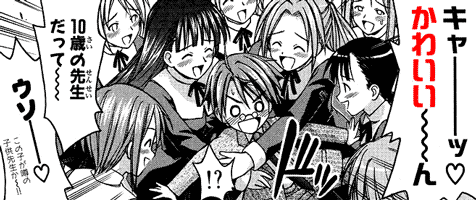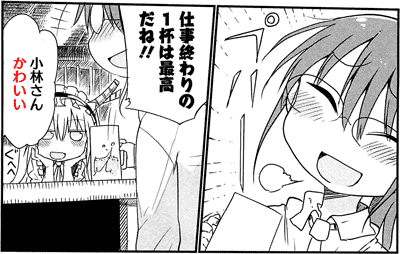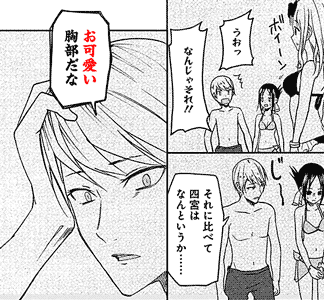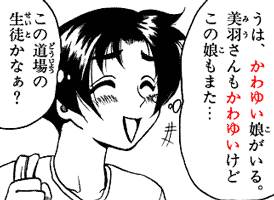In Japanese, kawaii 可愛い means "cute," and, sometimes, "pitiable." It's an i-adjective. It's also spelled kawaii かわいい, without kanji, and sometimes clipped to kawa かわ.
- {kawaii} onna-no-ko-tachi ga {kawaii} koto wo suru
可愛い女の子達が可愛いことをする
{Cute} Girls Doing {Cute} Things. - kawaikunai ko
可愛くない子
A non-cute kid. A brat.
Meaning
The word kawaii normally means "cute," "adorable," etc. It's typically used toward children, women, and small animals, just like cute in English.
- Context: Negi Springfield, ネギ・スプリングフィールド, is welcomed at a classroom.
- kyaa'♥
キャーッ♥
*fangirling noises* - kawaii~~n
かわいい~~ん
Cu~~ute. - juu-sai no sensei datte~~
10歳の先生だって~
[He] is a ten year old teacher, [I heard]~~ - uso~~♥
ウソーー♥
[No way]~~. - kono ko ga uwasa no {kodomo no} sensei ka~~!!
この子が噂の子供先生か~!!
This [boy] is the {child} teacher of the rumors~~?!!
- Context: Kobayashi 小林 drinks in the company of Tohru トール.
- See also: nomikai 飲み会.
- puhaa
プハー
*beer sigh*
- A satisfied sigh complete with smoke coming out of her mouth and radiated lines emanating from her.
- shigoto-owari no ippai wa saikou da ne!!
仕事終わりの1杯は最高だね!!
The one glass [after]-work is the best, [isn't it]!!- owari - noun form of owaru 終わる, "to end."
- shigoto-owari - end of work, i.e. after one's work ends.
- Kobayashi-san φ kawaii
小林さんかわいい
Kobayashi-san is cute.
- Context: the audience watching the theater play Futari no Joou ふたりの女王, "the two queens," is charmed by the adorable queen Ardis.
- kirei dashi, yasashii shi, akarui shi, kawaii shi...
きれいだし やさしいし 明るいし 可愛いし・・・
[She] is pretty, is gentle, is cheerful, is cute...- akarui
明るい
Bright. Well-lit. The opposite of dark.
Cheerful.
- akarui
- ore, mune-kyun! da ze
オレ胸キュン!だぜ
[I'm in love!]
Pitiable
The word kawaii can also mean "pitiable," as in deserving of pity, of sympathy. Things people generally consider cute—small animals, children, etc.—are also easily pitied and protected.
As a consequence, thinking something is kawaii means you'd pity it, and not pitying something means you don't think it's kawaii.
- Context: Nobita のびた's father told him to do chores outside, despite his complaints about the heat. So Nobita complains even more.
- konna hi ni soto e detara, nissha-byou ni naruzo.
こんな日に外へ出たら、日射病になるぞ。
If [I] leave in a sun like this, [I'll get] a sunstroke!- nissha-byou ni naru
日射病になる
To become so it's a "sun-shot-sickness."
To become so it's sunlight-sick.
To get a sunstroke.
- nissha-byou ni naru
- otousan wa, jibun no kodomo ga, kawaikunai no darou ka.
おとうさんは、自分の子どもが、かわいくないのだろうか。
To father, [his] own child isn't pitiable, [I wonder]?
- Doesn't he feel sorry for his own child, who has to go outside under the hot sun?
- wakatta!
わかった!
[I got it]! - boku wa hontou no ko janai-n-da.
ぼくは、ほんとうの子じゃないんだ。
I'm not [his] real child.
Pitiful
In general, cute, pitiable things that need to be protected need to be protected because they're weak, frail, small, and so on. The idea they need to be protected by a protector establishes a vertical hierarchy: the inferior, defenseless, weak thing, and the superior, strong protector.
Consequently, calling something cute in English or kawaii in Japanese may carry a nuance of inferiority. Calling something is cute, because it's pitiable, because it's small and weak, is just calling it small and weak with extra steps.
- Context: in this series, calling things kawaii condescendingly is a running gag, in this case said by Shirogane Miyuki 白銀御行 when comparing breast sizes of Fujiwara Chika 藤原千花 and Shinomiya Kaguya 四宮かぐや.
- boiin
ボイーン
*boing* - uwa'
うわっ
Whoa. - nanja sore!!
なんじゃそれ!!
- nanda sore!!
なんだそれ!!
What is that!!
- nanda sore!!
- ji~~
じ~~
*stare* - sore ni kurabete Shinomiya wa nanto iu ka......
それに比べて四宮はなんというか・・・・・・
Compared to that, Shinomiya [has], [how do I] say it...... - o kawaii kyoubu da na
お可愛い胸部だな
A cute chest, [I guess].- In the sense of small, compared to Fujiwara's boing-ing chest.
- See also: o kawaii koto お可愛いこと.
Conjugation
For reference, how to conjugate kawaii:
| Form | Translation |
|---|---|
| Nonpast form |
kawaii 可愛い To be cute. |
| Past form | kawaikatta 可愛かった Was cute. |
| Adverbial form | kawaiku 可愛く Cutely. |
| Eventivization |
kawaiku naru 可愛くなる To become cute. Will be cute. |
| kawaiku suru 可愛くする To make cute. |
|
| Negative form | kawaikunai 可愛くない To be not cute. |
| te-form | kawaikute 可愛くて To be cute, and. |
| Polite form | kawaii desu 可愛いです To be cute. |
| ba-form | kawaikereba 可愛ければ If is cute. |
| kawaikerya 可愛けりゃ |
|
| tara-form | kawaikattara 可愛かったら If is cute. |
| sa-form | kawaisa 可愛さ Cuteness. |
| meireikei of kari-conjugation |
kawaikare 可愛かれ Be cute. |
かわ
Sometimes, the ~i suffix of i-adjectives is clipped, e.g. sugoi すごい, "incredible," gets pronounced sugo すご, or kowai 怖い, "scary," gets pronounced kowa こわ. This is nonstandard, but can be found sometimes in casual speech.
In the case of kawaii, it also has an ~i suffix, but it's attached to a kawai~ stem, that also ends in ~i. The combination forms a long vowel (two ~i mora), and both ~i's get clipped instead of just the last one, becoming kawa.
Anime: Zombieland Saga: Revenge (Episode 6)
- Context: a random social media user comments on the legendary Yamada Tae, who is also known by the pseudonym "number 0," zero-gou 0号.
- See also: overly long sleeves.
- zero-gou kami-kawa!!!!!!!
0号神かわ!!!!!!!
Number 0 is super cute!!!!!!!
可哀想
The word kawaisou 可哀想 means "pitiable." It's typically used toward something or someone who appears to be suffering, "miserable," when something hidoi 酷い, "horrible," "cruel," is being done to them. The word is an ateji 当て字 coming from kawai-sou 可愛そう, "seemingly cute," "appearing pitiable." [日本国語大辞典]
- {{aware de}, {{hito no doujou wo sasou} you na} sama
あわれで、人の同情をさそうようなさま
In a way [that] {{is miserable and} seems to {invite people's sympathy}}.
There's a certain anime whose title in a play on this word:
- bokura wa minna Kawai-sou
僕らはみんな河合荘
We're all Kawai-sou.
We're all miserable.- ~sou ~荘 is a suffix for names of housing buildings, like "dormitory," "villa," "complex," etc. In this case, the series takes place in a building called "Kawai complex" in English, or Kawai-sou in Japanese.
Origin
The word kawaii かわいい originates in a change of pronunciation of kawayui かわゆい(デジタル大辞泉:可愛い), which in turn originates in kao-hayushi かおはゆし(also spelled 顔映ゆし), which meant "bashful," "embarrassed," hazukashii 恥ずかしい, omo-hayui 面映い.(デジタル大辞泉:かわゆい)
Both kao 顔 and omo 面 mean "face." Literally, it means someone's face is hayui 映い, hayushi comes from a shiku conjugation of hayui.
This hayui isn't used in modern Japanese, but it's likely synonymous with haeru 映える, "to look attractive," e.g. insuta-bae インスタ映え refers to a photo that would look good if posted in Instagram, an Instagrammable photo.
In summary: kao-hayushi meant looking bashful meant looking nice, which then meant looking cute.
- Context: boy sees girl.
- uha, {kawayui} ko ga iru.
うは、かわゆい娘がいる。
Wow, there is a {cute} girl [here]. - Miu-san mo kawayui kedo kono ko mo mata...
美羽さんもかわゆいけどこの娘もまた・・・
Miu-san, too, is cute, but girl, too, [is cute]...
- kono ko mo mata kawaii
この娘もまた可愛い
This girl, too, is cute. - See laughter lines for the #-shaped symbol next to his face.
- kono ko mo mata kawaii
- kono doujou no seito ka naa?
この道場の生徒かなぁ?
A student of this dōjō, [I wonder]?
References
- 可愛そう・可哀想(かわいそう)とは - 日本国語大辞典 via kotobank.jp, accessed 2019-03-21
- 可愛い(かわゆい) の意味 - デジタル大辞泉 via dictionary.goo.ne.jp, accessed 2021-09-13
- 可愛い - デジタル大辞泉 via kotobank.jp, accessed 2021-09-13.







No comments: